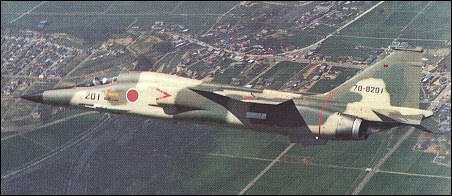|
| Japan's first indigenous combat aircraft to be produced after the end of World War II, the F-1 originated from a 1972 decision to develop a single-seat close air support fighter with secondary air-air capability from the Mitsubishi T-2 supersonic trainer. The overall performance of the latter was such that virtually no aerodynamic modifications had to be made, the principal change from the T-2 to the F-1 being the fairing over of the rear cockpit without changing the contours. The two prototypes of the F-1, both of which flew for the first time in June 1975, were modified T-2s with weapons systems equipment and test instrumentation in the rear cockpits. Powered by two 3207kg with afterburning Ishikawajima-Harima TF40-IHI-801A (licence-built Rolls -Royce/Turbomeca Adour) turbofans, the F-1 was armed with a single 20mm JM61 multi-barrel cannon in the lower front fuselage and had provision for up to 2721kg of bombs or rockets on the fuselage centreline and four wing hardpoints. Normal armament comprised two ASM-1 air-to-surface missiles and two or four AIM-9 Sidewinder AAMs. The Air Self-Defence Force purchased 77 F-1s, 70 of these being retrofitted during 1991-93 to enable them to remain in Air Self-Defence Force service until 1999-2000. The retrofit included installation of an advanced fire control system, provision of a stronger cockpit canopy and compatibility with the ASM-2 anti-shipping missile and XGCS homing bomb.

| WEIGHTS |
| Take-off weight | 13674 kg | 30146 lb |
| Empty weight | 6358 kg | 14017 lb |
| DIMENSIONS |
| Wingspan | 7.88 m | 26 ft 10 in |
| Length | 17.66 m | 58 ft 11 in |
| Height | 4.39 m | 14 ft 5 in |
| Wing area | 21.18 m2 | 227.98 sq ft |
| PERFORMANCE |
| Max. speed | 1700 km/h | 1056 mph |
| Range | 1100 km | 684 miles |
 | A three-view drawing (1278 x 730) |
| Oscar, e-mail, 08.03.2012 17:15 Looks like an F4 Vietnam vintage reply | | The AviatorDude, 29.08.2011 00:57 Shouldn't Japan have a frontline fighter instead of a SEPECAT Jaguar-like aircraft? reply |
|
Do you have any comments?
|
| 
COMPANY
PROFILE
All the World's Rotorcraft
|








